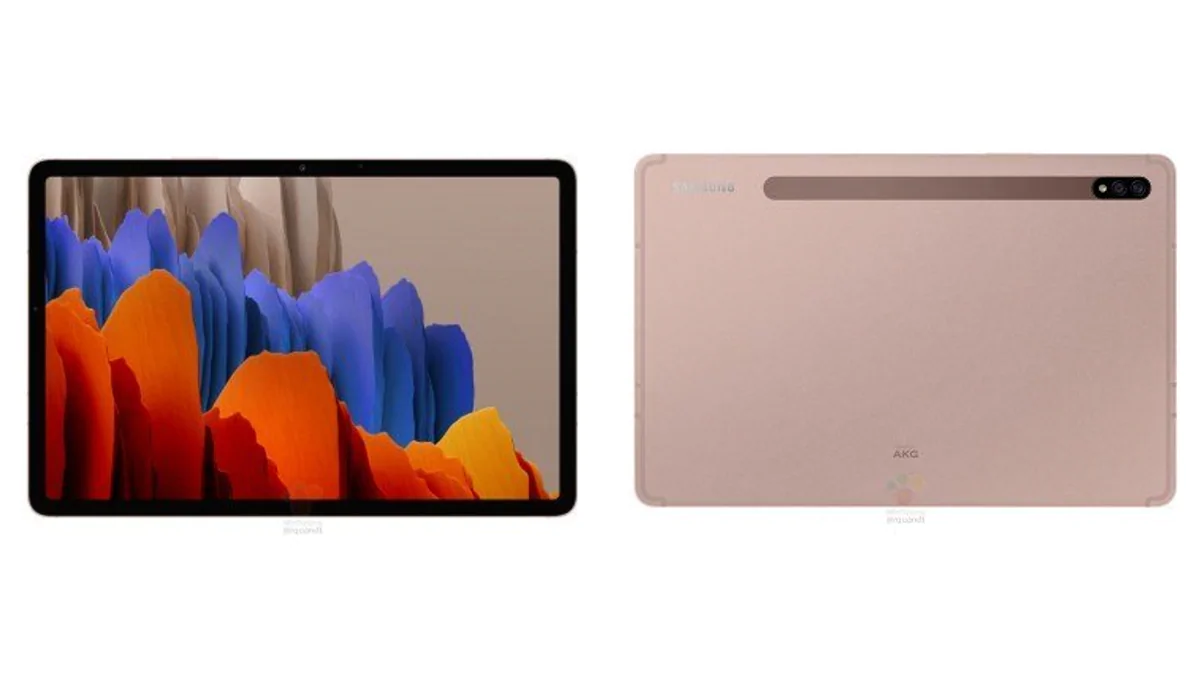[responsivevoice_button rate=”1″ pitch=”1.2″ volume=”0.8″ voice=”US English Female” buttontext=”Story in Audio”]
Samsung Galaxy Tab S7, Samsung Galaxy Tab S7+ Specifications and Renders Leaked Ahead of Launch
Samsung Galaxy Tab S7 and Samsung Galaxy Tab S7+ are largely rumoured to launch at the Samsung Galaxy Unpacked event on August 5. The South Korean giant is expected to launch the Galaxy Note 20 series at the event as well. A fresh leak online has now tipped the complete specifications of the two tablets ahead of launch, alongside detailed renders, leaving very little to the imagination. Both the Samsung Galaxy Tab S7 and Samsung Galaxy Tab S7+ are tipped to be powered by the Snapdragon 865+ octa-core SoC, and are reported to be 5G compatible.
Samsung Galaxy Tab S7, Samsung Galaxy Tab S7+ design (expected)
WinFuture.de has shared all information regarding the Samsung Galaxy Tab S7 and Samsung Galaxy Tab S7+ ahead of rumoured launch of August 5. The renders, published by the website, suggest that the two tablets look identical visually, and the only difference is in size. The tablets have lots of bezel on all sides, four speakers situated at two edges, and a USB Type-C port for charging. At the back, the tablets are seen to have dual camera setups. The Samsung Galaxy Tab S7 is tipped to have a side-mounted fingerprint scanner whereas the Samsung Galaxy Tab S7+ is reported to have an in-display fingerprint scanner on board. The two devices are expected to come in Mystic Black, Mystic Bronze or Mystic Silver options.
Samsung Galaxy Tab S7, Samsung Galaxy Tab S7+ specifications (expected)
The Samsung Galaxy Tab S7 is tipped to feature a 11-inch LTPS LCD display with 274ppi pixel density, 2,560×1,600 pixels resolution, and 500nits peak brightness. The display panel is said to support 120Hz refresh rate, and Samsung Galaxy Tab S7 is reported to have a side-mounted fingerprint scanner as well.

Samsung Galaxy Tab S7+ has a large 10,090mAh battery
The Samsung Galaxy Tab S7+, on the other hand, will reportedly pack a larger 12.4-inch (1,752×2800 pixels) Super AMOLED display with 287ppi pixel density, 420nits peak brightness, and 120Hz refresh rate. Because of the OLED display panel, the Samsung Galaxy Tab S7+ is reportedly to be featuring an in-display fingerprint scanner.
The tablets are tipped to be powered by the 3.09GHz Snapdragon 865+ SoC, paired with 6GB RAM and 128GB storage. The devices are expected to offer expansion of storage using a microSD card (up to 256GB).
The cameras on the Samsung Galaxy Tab S7 and Samsung Galaxy Tab S7+ are also tipped to be identical. The dual camera setups is expected to include a 13-megapixel primary sensor with f/2.0 aperture and a 5-megapixel ultra-wide-angle camera with f /2.2 aperture. Camera features are tipped to include 4K video recording at 30fps. Up front, both the tablets may feature a 8-megapixel selfie camera with f/2.0 aperture.
Samsung Galaxy Tab S7 is reported to pack a large 7.040mAh battery, whereas the Samsung Galaxy Tab S7+ is reported to carry a 10,090mAh battery. Fast charging support of up to 45W will reportedly be integrated into the tablets. Samsung is, however, expected to include a 15W charger inside the box. It will reportedly launch a new keyboard cover with a built-in trackpad for the two tablets as well, to enable users to convert them into durable Android laptops. There’s expected to be support for Wireless DeX, OneNote, and Microsoft Outlook as well. The four speakers are expected to be AKG and Dolby Atmos optimised.
Apart from the USB Type-C port, the two tablets are reportedly going to include connectivity options like Wi-Fi 802.11ax, Wi-Fi Direct, Bluetooth, GPS, GLONASS, Beidou, Galileo, ANT +, 5G, and more. Both the Samsung Galaxy Tab S7 and Samsung Galaxy Tab S7+are expected to support S Pen with 9 millisecond latency and air gesture support. The Samsung Galaxy Tab S7 is listed to measure 253.8×165.4×6.34mm and may weigh 495 grams, whereas the Samsung Galaxy Tab S7+ is listed to measure 285mm x 185mm x 5.7mm and weigh 590 grams.
Why are smartphone prices rising in India? We discussed this on Orbital, our weekly technology podcast, which you can subscribe to via Apple Podcasts, Google Podcasts, or RSS, download the episode, or just hit the play button below.



























